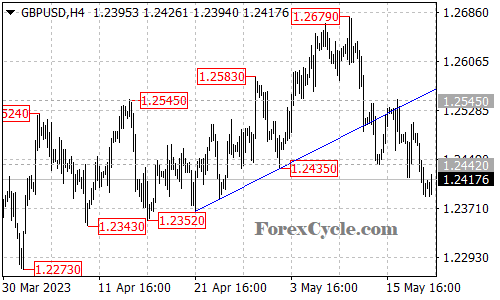The GBPUSD pair has experienced a continued downside move, with the price extending as low as 1.2391 from its recent peak at 1.2679. Traders and investors are closely observing the market as the pair remains under pressure, and further decline is anticipated.
The recent sell-off suggests a bearish bias for GBPUSD, and market participants are anticipating a potential continuation of the downward trend. Traders should remain vigilant and closely monitor the price action for any signs of a resumption in the bearish momentum.
As the pair navigates through the current market conditions, a further decline towards the next target at 1.2350 is likely. If the selling pressure intensifies, GBPUSD could aim for the 1.2280 level as the next support area. These levels are crucial and should be closely monitored by traders as they can influence the pair’s direction.
In terms of resistance, the near-term barrier for GBPUSD lies at 1.2442, followed by a key resistance level at 1.2545. Only a convincing break above these resistance levels would indicate a potential reversal in the current downtrend. Such a breakthrough could trigger another upward move towards the 1.2700 level, offering a glimmer of hope for bullish traders.
However, until a significant breakout occurs above the mentioned resistance levels, the bearish outlook remains intact. Traders should exercise caution and consider implementing risk management strategies to protect their positions in the face of potential market volatility.
In conclusion, the GBPUSD pair has extended its downward move, reaching as low as 1.2391. Further decline is anticipated, with the next target levels at 1.2350 and 1.2280. Near-term resistance is observed at 1.2442, while a key resistance level stands at 1.2545. Traders should closely monitor price movements and be prepared for potential market volatility. Implementing proper risk management strategies is crucial when trading GBPUSD in the current market conditions.


